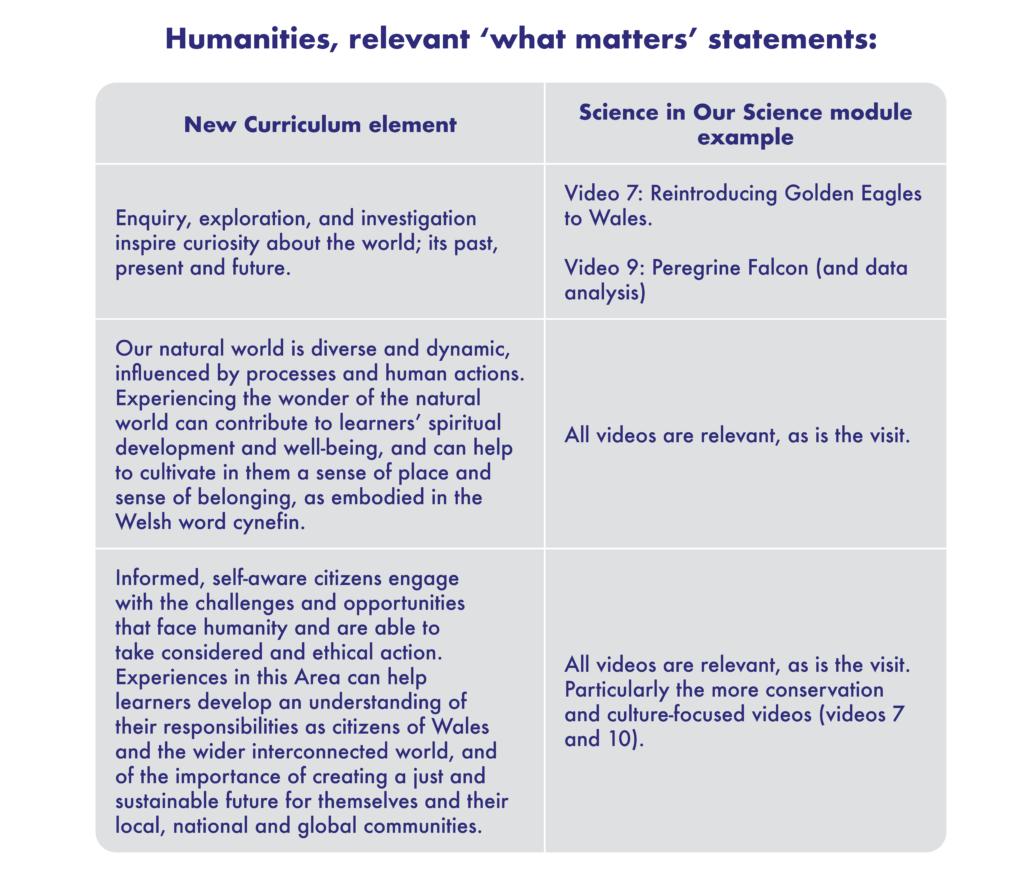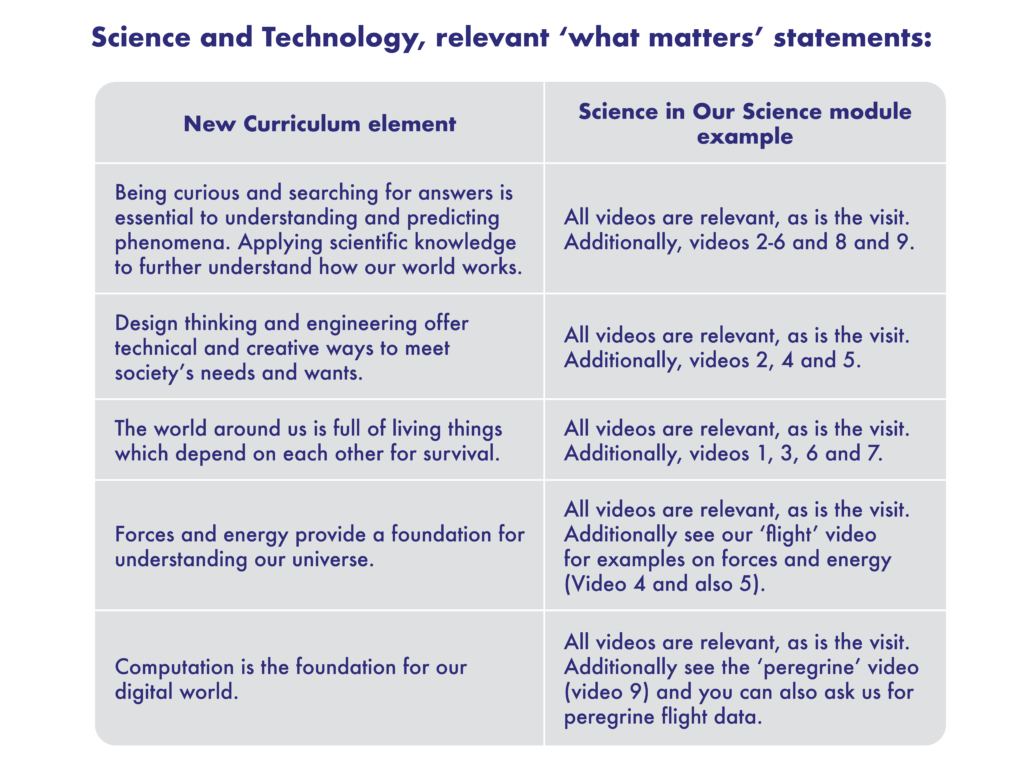Welcome to the teacher notes page that accompanies our visits to the British Bird of Prey Centre at the National Botanic Garden of Wales and associated resources! On this page, you will find curriculum information and worksheets that you can use to build lessons around the visits and further information sources. These worksheets accompany 10 fantastic videos which can be accessed by logging onto our portal and clicking on the “Science in our Skies button.
This is a new type of module for us where we have provided videos and resources that you can use to build upon your learners’ visit experience, while keeping in mind the New Curriculum’s methods of learning and teaching.
The videos explore; animal adaptations, the science of flight, how animals hunt, endangered animals and their conservation, and the cultural history of falconry and birds of prey in Wales.
The tables at the bottom of the page link an element of the New Curriculum to an example of a question that could be explored in this area, based on either the visit or the videos. We consider the videos and the experience to be best suited to New Curriculum Progression Steps 3 and 4 (Key Stage 2 to 3). There is a table below which explains the progression steps.
The videos explore themes that can be used in relation to New Curriculum What Matters Statements under the Humanities and Science and Technology Areas of Learning and Experience.

Ten videos accompany the Science in Our Skies outreach module. These wonderful videos were made for S4 by wildlife film-maker Ben Harris, and biologist and TV wildlife presenter Lizzie Daly. They provide an inspiring introduction to the topic for students who cannot attend the visit or for teachers to build on the visit themes, back at school.
This video follows a programme called Eagle Reintroduction Wales; a project to investigate the idea of reintroducing Golden Eagles to Wales. Golden Eagles are native to Wales but they were hunted to extinction over 400 years ago. The video looks at cross-disciplinary themes around hunting, conservation, agricultural and rural issues. This multidisciplinary video is suitable for sciences and humanities learning.
The Peregrine is the fastest bird, and one of the fastest animals, on the planet. The video looks at how Peregrines reach these speeds and what forces they are adapting to, to achieve such speeds. The video is most suitable to biology and physics themes. Accelerometer data from Peregrine flight can be provided for in-class data analysis lessons.
This video explores the cultural practice of falconry and some of the heritage of the use of birds of prey for hunting and leisure. The video is an interview with the team at the centre and can be used to think and talk about the cultural and social themes around falconry and heritage in the UK.
The table below gives examples of how you could link an element of The Science in Our Skies module,
to a New Curriculum What Matters Statement or Skills Area.


Curiosity and inquisitiveness. Many of the themes we explore around how birds of prey are adapted to their environment and how they use these adaptations to live, hunt and fly allow the development of curiosity and inquisitiveness skills.
Asking meaningful questions. The visit and the videos give many opportunities for learners to ask questions to increase the depth and breadth of their understanding of the themes we explore around flight, animal adaptations and the cultural aspects of falconry and birds of prey.
Evaluating evidence. The visit and videos are built around high-quality flight footage which is supplemented at the visit with many opportunities for learners to observe the birds both at rest and in flight and hunting and eating. There are opportunities for learners to apply the evidence they observe for how the birds utilise their adaptations. Additionally, we can provide flight data, from a tracker, on Enzo the Peregrine. This data will allow learners to explore peregrine flight, acceleration and manoeuvring and lends itself well to discussions on data analysis.
Empathy, emotional intelligence, and awareness. The centre is, at its heart, a conservation-focused space where highly rare and often endangered species are studied and cared for. Conservation is an excellent subject for the development of empathy and emotional intelligence skills and the hands-on elements of the visit will give your learners a chance to hold and interact with the incredible birds of prey at the centre.
Developing an appreciation of sustainable development and challenges facing humanity. The Centre works closely with projects such as the Eagle Reintroduction Wales programme. Golden Eagle’s used to live in Wales and the programme is exploring the possibility of reintroduction of the species to Wales. This programme is an excellent lens to look at conservation issues around hunting and agriculture. The centre also is home to five red and black kites – the species of Wales greatest species recovery story as these beautiful birds were hunted nearly to extinction in the past but are once again a part of the Welsh landscape thanks to conservation efforts!
We hope you find the Science in Our Skies Module useful and your learners enjoy the experience and the videos! Feel free to get in touch via s4science@swansea.ac.uk if you need any additional information!
Below you can find links to worksheets for the module.
This worksheet is about how owls’ feathers help them hunt.
This bumper worksheet will introduce pupils to the different adaptations that make birds of prey amazing hunters.
In this worksheet, pupils will learn about the amazing digestive system of owls and dissect their own owl pellets.
This illustrated guide accompanies the Owl Pellet worksheet to help pupils identify the prey in their owl pellet.
Pupils will discover how owls hide in plain sight with this worksheet.
Pupils will learn about Owls’ spectacular eyesight which helps them hunt at night.
Pupils will learn about owl hearing and how their hearing adaptations inspired engineers.
This worksheet explores how birds of prey use UV light to spot their prey.